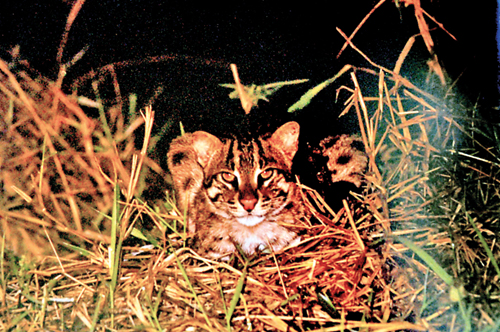Diving into an adventure with Fishing Cats
 The booklet came to my hands when I was laid up in bed and instantly transported me to the rural beauty of Sigiriya, where lingers a cat similar but at the same time different to the pet felines we see so often.
The booklet came to my hands when I was laid up in bed and instantly transported me to the rural beauty of Sigiriya, where lingers a cat similar but at the same time different to the pet felines we see so often.
Small and handy, ‘The Fishing Cat – Elusive Feline in the Wetlands’ by Chaminda Jayasekara is packed full of beautiful photographs mostly by the writer himself.
Clearly and succinctly numerous details, along with photographs, about the Fishing Cat are contained in this book, with Chaminda who is Assistant Manager of Jetwing Vil Uyana in Sigiriya having spotted all three species of recorded Small Cats in Sri Lanka at the hotel premises.
It was back in 2014 that Chaminda meticulously wrote and captured on camera everything including pug marks and scat identification and in 2017 set camera traps as these creatures are shy by nature.
Six Fishing Cats feature in the book and include ‘Theesa’, the first female and ‘Zeeja’, the first male, all identified by their size, unique facial markings, spot patterns and the places they haunt frequently. Interestingly, ‘Theesa’ and ‘Zeeja’ have been observed using the same place to rest, day and night.

Chaminda
Before turning the spotlight on Fishing Cats, Chaminda systematically guides the reader through wild cat species, both big and small, in the world, closing in on the latter with the explanation that they come from seven lineages. He delves further into the two lineages that interest Sri Lankans, the ‘Leopard Cat’ lineage and the ‘Felis’ lineage.
Picking up the trail of all wild cats in Sri Lanka, Chaminda details in black and white that while the only Big Cat found in the wilds is the magnificent leopard (Panthera pardus kotiya), the two Small Cat-cousins of the leopard here are: the Fishing Cat (Prionailurus viverinus) and the Rusty-spotted Cat (Prionailurus rubiginosus) of the Leopard Cat lineage and the third Small Cat is the Jungle Cat (Felis chaus) of the Felis lineage.
Interesting little nuggets emerge thereafter about Fishing Cats, the second largest wild Small Cats: habitat and habits – how they “love” the water and wetlands and are not only good tree climbers but also good swimmers and while being nocturnal are also active during the day, hunting solitarily for fish as their name denotes as also frogs, snakes, rats and surprisingly nocturnal birds such as night herons.
“…….Suddenly the Fishing Cat jumped to the other side of the canal and quickly caught something. We realized it was the night heron we had spotted earlier,” says Chaminda in a first-person account.
Their varied fish-catching techniques make fascinating reading – jumping into the water and grabbing the fish with their paws or slightly tapping the surface of the water with their paws to imitate a struggling insect to attract the fish and then catching them in a flash.
Through photographs, Chaminda pinpoints the characteristics of these territorial felines and shows how we can distinguish between males and females…..for the males are slightly bigger with broader faces which give them a more aggressive look. From face-and-body markings, he goes on to pugmarks from their partially-webbed feet, with four-toe imprints.
Not content with just these descriptions, the writer also deals with threats such as road kills, habitat degradation and pollution and conflicts (traps and electric fences) with humans that these Fishing Cats face and what can be done to conserve these creatures.
With the sole aim of the booklet being to get more people interested in Small Cats which should not be overshadowed by the Big Cat in Sri Lanka, it sure gives the rightful place to Fishing Cats which are deemed globally vulnerable and nationally endangered.
Earlier, Chaminda’s penchant for the wilds – sparked by his childhood explorations around his home and school at Nelumwewa, Polonnaruwa – saw publications such as the ‘Dry Zone Slender Loris’ and ‘Wildlife in and around Vil Uyana’ rolling off the presses. His passion was also the catalyst for the establishment of a Loris Conservation Site, a first in the country, and a Fishing Cat Research Project at Vil Uyana.
Chaminda’s ardent wish is that everyone who picks up and flips through this booklet would spare a thought for Fishing Cats which, in turn, would enhance conservation efforts directed at them.


